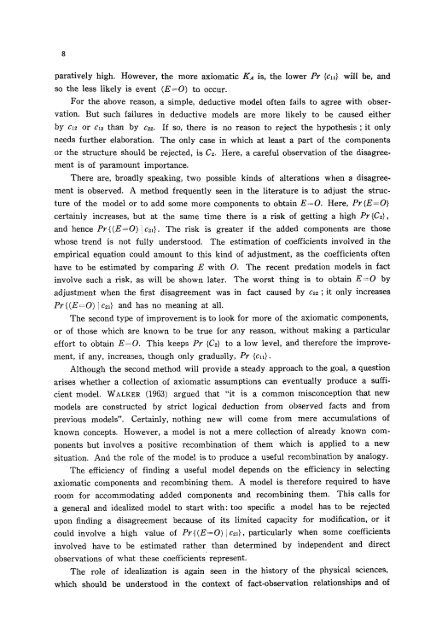A comparative study of models for predation and parasitism
A comparative study of models for predation and parasitism
A comparative study of models for predation and parasitism
Create successful ePaper yourself
Turn your PDF publications into a flip-book with our unique Google optimized e-Paper software.
paratively high. However, the more axiomatic K~ is, the lower Pr {cn} will be, <strong>and</strong><br />
so the less likely is event (E=O) to occur.<br />
For the above reason, a simple, deductive model <strong>of</strong>ten fails to agree with obser-<br />
vation. But such failures in deductive <strong>models</strong> are more likely to be caused either<br />
by c~2 or c~3 than by c2z. If so, there is no reason to reject the hypothesis ; it only<br />
needs further elaboration. The only case in which at least a part <strong>of</strong> the components<br />
or the structure should be rejected, is C~. Here, a careful observation <strong>of</strong> the disagree-<br />
ment is <strong>of</strong> paramount importance.<br />
There are, broadly speaking, two possible kinds <strong>of</strong> alterations when a disagree-<br />
ment is observed. A method frequently seen in the literature is to adjust the structure<br />
<strong>of</strong> the model or to add some more components to obtain E=O. Here, Pr{E=O}<br />
certainly increases, but at the same time there is a risk <strong>of</strong> getting a high Pr{C2},<br />
<strong>and</strong> hence Prl(E=O)[c21}. The risk is greater if the added components are those<br />
whose trend is not fully understood. The estimation <strong>of</strong> coefficients involved in the<br />
empirical equation could amount to this kind <strong>of</strong> adjustment, as the coefficients <strong>of</strong>ten<br />
have to be estimated by comparing E with O. The recent <strong>predation</strong> <strong>models</strong> in fact<br />
involve such a risk, as will be shown later. The worst thing is to obtain E=O by<br />
adjustment when the first disagreement was in fact caused by c22 ; it only increases<br />
Prl(E=O)]c21} <strong>and</strong> has no meaning at all.<br />
The second type <strong>of</strong> improvement is to look <strong>for</strong> more <strong>of</strong> the axiomatic components,<br />
or <strong>of</strong> those which are known to be true <strong>for</strong> any reason, without making a particular<br />
ef<strong>for</strong>t to obtain E=O. This keeps Pr {C2} to a low level, <strong>and</strong> there<strong>for</strong>e the improve-<br />
ment, if any, increases, though only gradually, Pr {c1~}.<br />
Although the second method will provide a steady approach to the goal, a question<br />
arises whether a collection <strong>of</strong> axiomatic assumptions can eventually produce a suffi-<br />
cient model. WALKER (1963) argued that "it is a common misconception that new<br />
<strong>models</strong> are constructed by strict logical deduction from observed facts <strong>and</strong> from<br />
previous <strong>models</strong>". Certainly, nothing new will come from mere accumulations <strong>of</strong><br />
known concepts. However, a model is not a mere collection <strong>of</strong> already known com-<br />
ponents but involves a positive recombination <strong>of</strong> them which is applied to a new<br />
situation. And the role <strong>of</strong> the model is to produce a useful recombination by analogy.<br />
The efficiency <strong>of</strong> finding a useful model depends on the efficiency in selecting<br />
axiomatic components <strong>and</strong> recombining them. A model is there<strong>for</strong>e required to have<br />
room <strong>for</strong> accommodating added components <strong>and</strong> recombining them. This calls <strong>for</strong><br />
a general <strong>and</strong> idealized model to start with: too specific a model has to be rejected<br />
upon finding a disagreement because <strong>of</strong> its limited capacity <strong>for</strong> modification, or it<br />
could involve a high value <strong>of</strong> Pr{(E=O)Ic2~}, particularly when some coefficients<br />
involved have to be estimated rather than determined by independent <strong>and</strong> direct<br />
observations <strong>of</strong> what these coefficients' represent.<br />
The role <strong>of</strong> idealization is again seen in the history <strong>of</strong> the physical sciences,<br />
which should be understood in the context <strong>of</strong> fact-observation relationships <strong>and</strong> <strong>of</strong>















